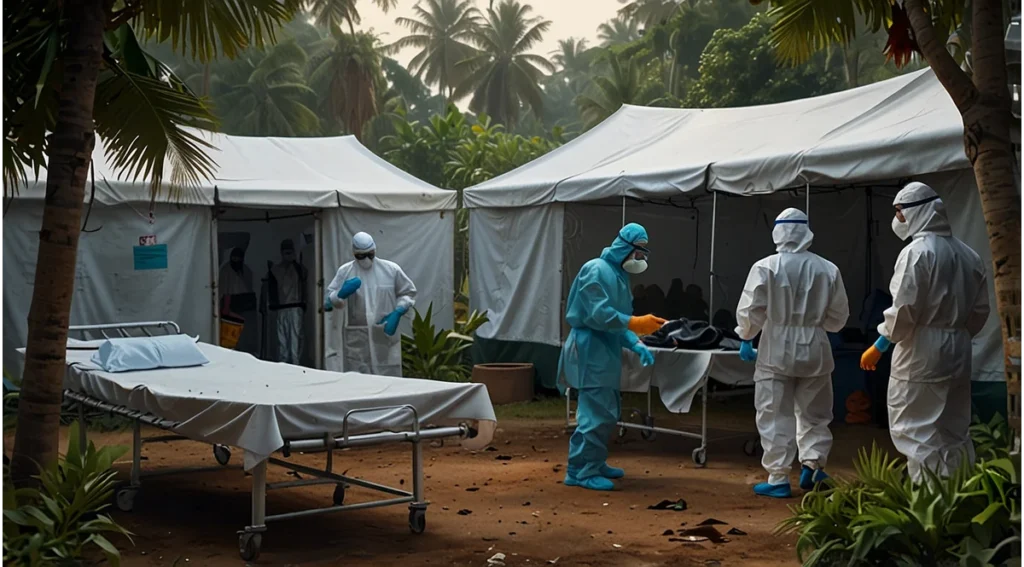In July 2025, the Indian state of Kerala witnessed a renewed outbreak of the deadly Nipah virus, triggering nationwide concern and global alerts. With high mortality rates and potential for rapid transmission, Nipah virus is now being viewed by experts as one of the top contenders for the next global pandemic.
But what exactly is Nipah virus? Why is it so dangerous? And what can be done to prevent its spread?
Let’s dive into everything you need to know about the latest Nipah outbreak, its origin, symptoms, spread, treatment, and the urgent public health response.
🧬 What is Nipah Virus?
Nipah virus (NiV) is a zoonotic virus (a virus that spreads from animals to humans) that was first identified in 1998–99 in Malaysia and Singapore. It belongs to the Paramyxoviridae family and is closely related to Hendra virus.
The natural reservoir for Nipah virus is the fruit bat (genus Pteropus), also known as the flying fox. These bats can transmit the virus to animals like pigs or directly to humans through saliva, urine, or partially eaten fruits.
📍 July 2025 Outbreak – What Happened?
In early July 2025, health authorities in Kozhikode district, Kerala, confirmed multiple cases of Nipah virus infection. Local hospitals started reporting patients with fever, altered consciousness, and severe respiratory distress.
By mid-July:
- Over a dozen suspected cases had been identified.
- Four people had died, including one healthcare worker.
- More than 300 close contacts were placed under quarantine.
- Schools were closed in affected districts.
- The Indian government deployed National Centre for Disease Control (NCDC) teams for rapid outbreak response.
🚨 Why is Nipah Virus So Concerning?
Several reasons make Nipah virus especially dangerous:
- High Fatality Rate: The case fatality rate (CFR) ranges between 40% to 75%, making it far more lethal than COVID-19.
- Human-to-Human Transmission: Unlike some zoonotic viruses, Nipah can spread from person to person, especially through close contact, respiratory droplets, or body fluids.
- No Approved Treatment or Vaccine: There are currently no specific antivirals or vaccines approved for Nipah. Management is supportive only.
- Long Incubation Period: The virus has an incubation period of 4 to 14 days, sometimes up to 45 days, which allows undetected spread.
- Potential for Mutation: The virus may mutate and become more transmissible, raising fears of a future pandemic.
🩺 Signs and Symptoms
Symptoms of Nipah infection usually appear within 4 to 14 days after exposure. They include:
- Fever and headache
- Drowsiness or confusion
- Cough or sore throat
- Vomiting
- Difficulty breathing
- Seizures or coma in severe cases
Encephalitis (inflammation of the brain) is a hallmark complication and can develop rapidly, leading to death.
🧪 Diagnosis and Testing
Diagnosis is done using:
- Real-Time PCR (RT-PCR) from throat/nasal swabs or cerebrospinal fluid.
- ELISA-based antibody detection
- Post-mortem analysis in fatal cases.
Because of its severity and contagious nature, samples are handled in high biosafety laboratories (BSL-4).
🛡️ Treatment and Prevention
Currently, there is no approved antiviral treatment for Nipah virus. Supportive care is the mainstay, which includes:
- Oxygen therapy
- Intravenous fluids
- Managing seizures and encephalitis
- ICU care for critical cases
Prevention Strategies:
- Avoid eating half-eaten fruits.
- Avoid contact with bats or pigs.
- Practice strict hygiene and mask-wearing in affected areas.
- Isolate suspected or confirmed cases.
- Strengthen surveillance and contact tracing.
🌍 Global Response and WHO Involvement
The World Health Organization (WHO) has listed Nipah virus as one of the top priority pathogens for research and preparedness. The WHO has called for:
- Investment in vaccine research
- Global surveillance systems
- Cross-border collaboration in South Asia
This outbreak in 2025 has reignited efforts for a “One Health” approach that links human, animal, and environmental health together.
🧩 Conclusion
The July 2025 Nipah outbreak in Kerala is a vivid reminder that the world remains at risk for high-impact zoonotic diseases. With its high fatality rates and potential for mutation, this virus stands as a top candidate for next pandemic threats. Rapid response, surveillance, and coordinated global efforts are essential to prevent a local outbreak from becoming a global emergency.
Stay updated, stay prepared, and share accurate information — because early intervention saves lives.



